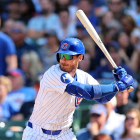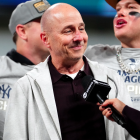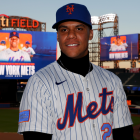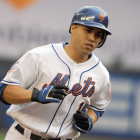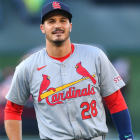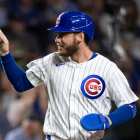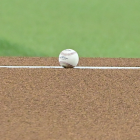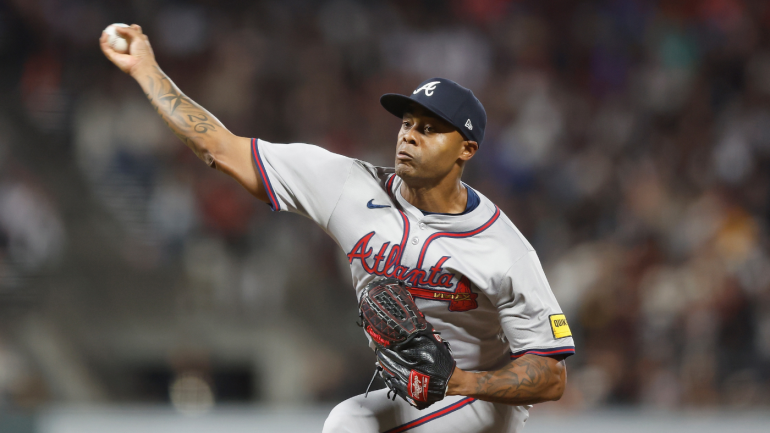
September is right around the corner, meaning the postseason races (and awards races) are really heating up and everything will be decided in less than five weeks. The marathon that is the regular season is becoming a sprint to the finish. With that in mind, here now are three MLB trends worth knowing as we enter the stretch run.
Iglesias' hidden perfect game
I think we can all agree Emmanuel Clase has been the best closer -- really the best reliever -- in baseball this season. He's been out of this world good. Mason Miller has been excellent too and has the shiny new toy glow (and a 104 mph fastball). Kirby Yates has been great. Jeff Hoffman, AJ Puk, Ryan Walker, on and on we could go. There are a lot of great relievers out there.
For my money, Braves closer Raisel Iglesias has been the second-best reliever in baseball this season. He took a 1.39 ERA and 0.60 WHIP -- 0.60 WHIP! -- into Tuesday's game, and he'd struck out 50 batters against only seven unintentional walks. Only Clase has been better in terms of win probability added. Iglesias has gotten an awful lot of high-leverage outs for Atlanta.
Last Friday, Iglesias threw scoreless ninth and tenth innings in an eventual walk-off win over the Nationals. He hit Jacob Young with a pitch leading off the tenth, which is notable because it snapped Iglesias' streak of 38 consecutive batters retired. It's a hidden perfect game! That's 27 straight retired plus 11 more spanning 12 appearances from July 30 to Aug. 23.
Raisel Iglesias's streak of retiring 38 consecutive hitters ends with a HBP. pic.twitter.com/EeM7StwUlg
— Rob Friedman (@PitchingNinja) August 24, 2024
Of course, an actual perfect game is way cooler than a reliever beating 27-plus batters across however many appearances, but still, it's really, really hard to retire 38 straight batters. Per MLB.com, Iglesias' streak is the longest by a Braves pitcher in the Expansion Era (since 1961), and it's the longest by any pitcher since Yusmeiro Petit set the all-time record in 2024.
Here are the longest streaks of consecutive batters retired in baseball history:
- Yusmeiro Petit, 2014 Giants: 46
- Mark Buehrle, 2009 White Sox: 45
- Bobby Jenks, 2007 White Sox: 41
- Jim Barr, 1972 Giants: 41
- Tom Browning, 1988 Reds: 40
Buehrle's and Browning's perfect games were part of their streaks. As for Iglesias, he plunked Young, retired the next batter on a pop up to second, then got a 1-6-3 double play to escape the inning. Going into Tuesday, Iglesias had retired 40 of the last 41 batters he'd faced, and he had not given up a hit to any of the last 43 batters he'd faced. He's been dominant.
The Braves have gotten hammered by injuries this year and their offense has suffered, so the margin of error for the pitching staff has shrunk. The back of the bullpen -- Joe Jiménez, Pierce Johnson, Dylan Lee, etc. -- has been quite strong though, and Iglesias has been almost automatic in the ninth inning. He's making leads stand up and has been almost flawless for a month now.
Francis earning spot in Blue Jays' rotation
Thanks to a strong spring training and Alek Manoah's shoulder injury, righty Bowden Francis opened 2024 in the Blue Jays' rotation, and it didn't go well. He allowed 12 runs and four homers in 8 1/3 innings in his first two starts, then a forearm injury sidelined him from late April to early June. When he returned, Francis initially worked as a low-leverage reliever.
Toronto's season went south, so the Blue Jays sold at the trade deadline, and sending Yusei Kikuchi to the Astros opened a rotation spot. That gave the 28-year-old Francis another crack at a starting job and he's been outstanding. This past Saturday he took a no-hitter into the ninth inning against the Angels, and struck out a career-high 12 batters in eight innings.
Francis has allowed four runs total in four starts since rejoining the rotation, and he's gone at least seven innings in each of his last three starts. In those three starts, he's allowed two runs on five hits (!) and three walks while striking out 27 in 22 innings. That works out to a .070/.120/.169 batting line. Even in a three-start sample, that is just incredible.
"I am very proud of him right now," Blue Jays star Vladimir Guerrero Jr. said after Francis' no-hit bid Saturday (via MLB.com). "We all know that at the beginning of the season, things weren't going his way. The last four or five outings, he's been incredible. Today was unbelievable."
This excellent four-start stretch comes with a change in pitch mix. Francis has scaled back on his loopy low-70s curveball and is now throwing more mid-80s splitters. Hitters have slugged .614 against his curveball this year. The splitter has performed much better (only a .172 slugging against) because hitters put it on the ground more than 60% of the time.
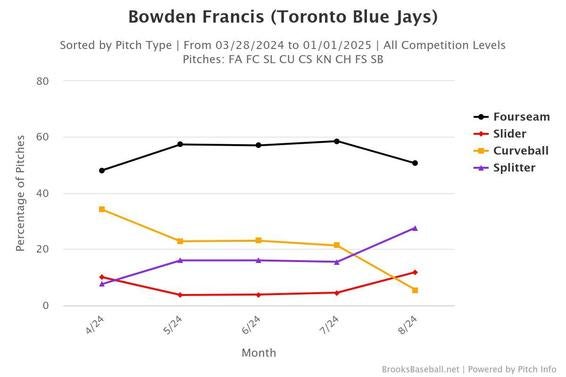
The curveball and splitter have similar whiff rates -- hitters have missed with roughly 22% of their swings against both pitches this year -- though the splitter is trending up (27% whiffs in August), and again, it's an extreme ground-ball pitch. Francis is having a great August and, not coincidentally, he's throwing fewer hittable curveballs and more high-whiff/high-grounder splitters.
Acquired from the Brewers in the Rowdy Tellez trade a few years ago, Francis was never once ranked as a top-30 prospect in his team's farm system by Baseball America, but he performed throughout the minors and earned his first big-league call up in 2022. Thanks to a second opportunity in the rotation and a new pitch mix, he looks to have some staying power in Toronto's rotation.
The sloppy Red Sox
Monday at Fenway Park, Danny Jansen became the first player ever to play for both teams in one game. You can thank a June 26 suspended game for that. Jansen was in the lineup (and at the plate!) for the Blue Jays when the game was suspended. He was traded to the Red Sox on July 27 and inserted into their lineup when the game resumed. So there you go. Two teams, one game.
Once the pomp and circumstance of Jansen entering the game for the Red Sox was done with, the Blue Jays swept the day's doubleheader, and the Red Sox made six errors in the two games. They made all six Monday too, rather than one or two back before the game was suspended on June 26. No, six errors in one day. It was pretty ugly.
The six errors Monday led to five unearned runs in the two games, or more runs than the Red Sox scored themselves in the doubleheader (four). Unearned runs have been a problem for Boston all season. Entering play Tuesday, the Red Sox had allowed 85 unearned runs, 21 more than any other team. They have a 3.96 ERA but are allowing 4.85 actual runs per nine innings.
The Red Sox are on pace to allow 105 unearned runs and, incredibly, 13.4% of the runs they've allowed this season have been unearned. That's roughly one out of seven. Here are the last five teams to allow that many unearned runs (ignoring 2020):
| Total unearned runs | Unearned run rate |
|---|---|
2008 Rangers: 107 | 1993 Expos: 15.8% |
1999 Devil Rays: 108 | 1993 Dodgers: 13.4% |
1999 Expos: 105 | 1992 Dodgers: 14.3% |
1996 Red Sox: 111 | 1988 Expos: 13.9% |
1996 Giants: 105 | 1985 Astros: 14.0% |
For whatever reason (better defenders, more generous scoring, etc.), errors are trending down league-wide, and have been for decades. There have been 0.53 errors per game in 2024. Go back to 2014 and it was 0.60 errors per game. In 2004, it was 0.65 errors per game. Go back another 10 years and it was 0.74 errors per game. For one reason or another, errors are disappearing.
Errors may be on the decline but so too are unearned runs. They go hand in hand. What the 2024 Red Sox are doing really is hard to believe. Despite unearned runs being at such a low point historically, Boston is on pace to allow the most since 2008 and the second most since 1999. It's been three decades since unearned runs made up such a large percentage of a team's runs allowed.
The Red Sox lead baseball with 98 errors (duh), 12 more than any other team, and while we know errors are not the best way to evaluate an individual player's defense, they do indicate sloppiness at the team level. The Red Sox screw up a lot defensively. It's not a secret. Watch them on any given night and you'll see it. They give away way too many extra outs.
Trevor Story's return, which could happen at some point this year, will help the infield defense. Boston's shortstops are dead last among the 30 teams with minus-13 outs above average. They also grade out poorly at second (minus-8) and third (minus-9) bases. Basically, the Red Sox have poorly defense all over the infield. Story is one man and can only help so much.
Bad defense hurts in so many ways. It's not just extra outs for the other team. You're making your pitcher throw more pitches (and more high-stress pitches with men on base), you're putting greater strain on the bullpen, etc. The second half swoon means it's probably too late for the Red Sox to get to the postseason. That gives them plenty of time to work on improving the defense over the winter.










